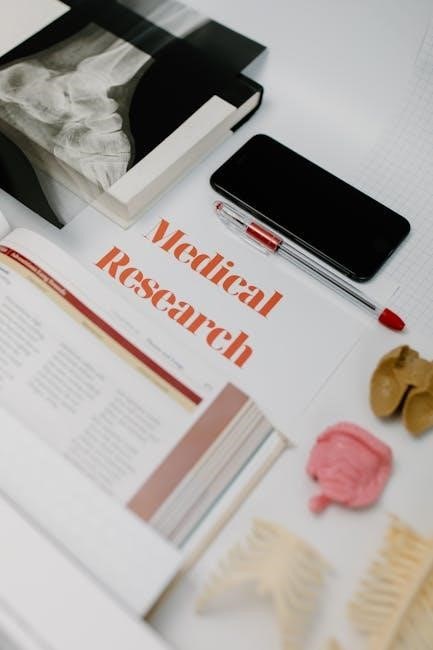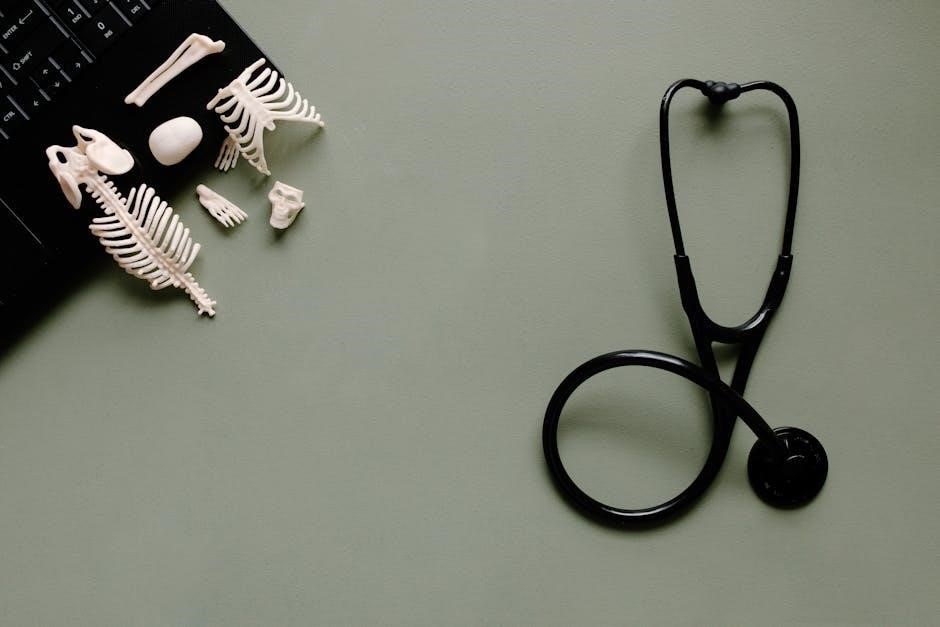Nursing is a vital healthcare profession focused on patient care, promoting health, and preventing illness. It combines compassion with scientific knowledge to enhance patient outcomes and well-being.
1.1 What is Nursing?
Nursing is a healthcare profession focused on providing care to individuals, families, and communities to promote health and well-being. It involves the nursing process, a systematic approach to patient care.
Nurses assess, diagnose, plan, implement, and evaluate care tailored to patient needs, emphasizing a holistic, patient-centered approach. Nursing blends science with compassion, addressing physical, emotional, and social aspects of health.
1.2 The Role of Nurses in Healthcare
Nurses play a central role in healthcare, providing direct patient care, administering medications, and monitoring health conditions. They collaborate with doctors and other professionals to develop care plans, educate patients, and promote wellness. Nurses also offer emotional support to patients and families, acting as advocates to ensure personalized care. Their adaptability and dedication make them indispensable in various healthcare settings, from hospitals to community clinics.
1.3 Importance of Nursing Education
Nursing education is crucial for building a strong foundation in patient care, clinical skills, and critical thinking. It ensures nurses are well-prepared to provide safe, evidence-based care and adapt to evolving healthcare needs.

Foundational Concepts in Nursing
Foundational concepts in nursing include theories, models, and principles guiding practice. They shape holistic, patient-centered approaches. Understanding these is crucial for effective, evidence-based practice.
2.1 Anatomy and Physiology Basics
Anatomy and physiology are fundamental to nursing, providing a understanding of the human body’s structure and functions. Nurses study body systems, such as the cardiovascular, respiratory, and nervous systems, to comprehend how they interact. Knowledge of homeostasis, cell biology, and organ functions enables nurses to identify abnormalities and respond appropriately. This foundation is crucial for assessing patients, interpreting symptoms, and developing effective care plans.
- Focuses on body systems and their inter relationships.
- Essential for understanding health and disease processes.
- Applies to patient assessment and care interventions.
2.2 Key Nursing Theories and Models
Key nursing theories, like Florence Nightingale’s Environmental Theory, Virginia Henderson’s Nursing Process Theory, and Betty Neuman’s Systems Model, provide frameworks for understanding patient care. These theories guide evidence-based practice, research, and education, emphasizing holistic, patient-centered approaches. They help nurses address physical, emotional, and social needs, fostering optimal health outcomes and individualized care. Understanding these theories is essential for developing a strong foundation in nursing practice and decision-making.
2.3 Ethical and Legal Considerations
Ethical and legal considerations in nursing are crucial for maintaining patient trust and ensuring safe practice. Nurses must uphold principles like patient autonomy, confidentiality, and informed consent. Legal issues such as malpractice and negligence require adherence to professional standards. Understanding ethical frameworks and legal responsibilities helps nurses navigate complex situations, minimizing risks and promoting quality care. Continuous education is essential to stay updated on evolving laws and ethical guidelines.

Clinical Skills for Nurses
Clinical skills are essential for nurses to deliver safe and effective patient care. These include patient assessment, vital sign measurement, and medication administration, forming the core of nursing practice.
3.1 Assessment and Diagnostic Techniques
Assessment and diagnostic techniques are essential for nurses to accurately evaluate patients’ conditions. These include physical assessments, reviewing medical histories, and utilizing tools like stethoscopes and blood pressure cuffs. Additionally, diagnostic tests such as lab work and imaging may be employed. Accurate assessments guide the development of individualized care plans, ensuring targeted interventions and improving patient outcomes through effective monitoring and timely adjustments to treatment, ultimately enhancing the quality of care provided.
3.2 Vital Sign Measurement and Interpretation
Vital sign measurement is a cornerstone of nursing practice, providing essential data on a patient’s physiological state. Nurses measure temperature, pulse, respiratory rate, blood pressure, and oxygen saturation. Accurate measurement requires proper technique and equipment. Normal ranges vary by age and health status, with deviations indicating potential issues. Interpretation involves identifying patterns, trends, and abnormalities to guide care decisions. Timely documentation ensures continuity of care and informed clinical interventions.
3.3 Medication Administration and Safety
Medication administration is a critical nursing skill requiring precision and adherence to safety protocols. Nurses must verify the “7 rights”: right patient, drug, dose, route, time, reason, and documentation. Understanding pharmacokinetics and pharmacodynamics ensures proper dosing intervals. Barcode scanning and double-checking orders reduce errors. Regular patient monitoring for side effects and adverse reactions is essential. Maintaining asepsis during administration prevents infection risks. Proper documentation ensures continuity of care and legal compliance.

Patient Care and Communication
Patient care and communication are cornerstone skills in nursing, ensuring personalized, empathetic interactions. Clear communication fosters trust and understanding, essential for positive patient outcomes and satisfaction.
4.1 Effective Communication in Nursing
Effective communication in nursing is crucial for building trust and ensuring accurate information exchange between patients, families, and healthcare teams. It involves active listening, clear verbal and non-verbal cues, and empathy. Nurses must adapt communication strategies to meet diverse patient needs, including cultural and language barriers. Professionalism and clarity in documentation also enhance care coordination. Strong communication fosters collaboration, improves patient outcomes, and reduces errors, making it a cornerstone of high-quality nursing practice.
4.2 Cultural Competence in Patient Care
Cultural competence in patient care involves understanding and respecting diverse patient backgrounds, beliefs, and values. Nurses must recognize cultural differences in health practices, communication styles, and decision-making. This competence enhances trust, improves care quality, and ensures patient satisfaction. It requires self-awareness, cultural assessments, and adapting care plans to meet individual needs. Effective cultural competence fosters a patient-centered approach, ensuring equitable and compassionate care across diverse populations.
- Promotes patient trust and engagement
- Addresses health disparities
- Ensures tailored care delivery
4.3 Patient Education and Health Literacy
Patient education empowers individuals to manage their health effectively. Nurses play a crucial role in teaching patients about medications, treatments, and self-care. Health literacy ensures patients understand medical information, fostering informed decision-making. Effective education involves clear communication, cultural sensitivity, and tailored strategies. It improves health outcomes, enhances patient engagement, and reduces hospital readmissions. Addressing health literacy gaps is essential for equitable care and patient autonomy. Nurses must adapt education to meet diverse patient needs and learning styles.

Pharmacology in Nursing
Pharmacology in nursing involves understanding drug classes, mechanisms, and safe administration practices. Nurses play a crucial role in managing medications and monitoring for adverse effects to ensure patient safety.
5.1 Drug Classes and Mechanisms
Drug classes are groups of medications with similar therapeutic effects or chemical structures. Common classes include analgesics, antibiotics, and anticoagulants. Mechanisms of action describe how drugs interact with the body, such as receptor binding, enzyme inhibition, or blocking ion channels. Understanding these concepts is crucial for predicting drug effects, managing side effects, and ensuring safe administration in clinical practice. Nurses must grasp these principles to provide effective patient care and optimize treatment outcomes.
5.2 Common Medications in Nursing Practice
In nursing practice, common medications include analgesics like acetaminophen and ibuprofen, antihypertensives such as lisinopril, and antimicrobials like amoxicillin. Nurses must understand drug classifications, dosages, and potential side effects to ensure safe administration. Familiarity with medications like insulin, heparin, and opioids is crucial for patient care. Monitoring for adverse reactions and educating patients on proper use are key responsibilities for nurses in clinical settings.
5.3 Adverse Drug Reactions and Management
Adverse drug reactions (ADRs) are unwanted effects of medications. Nurses must identify signs like rashes, nausea, or respiratory distress. Management involves assessing severity, discontinuing the drug if necessary, and administering antidotes. Monitoring vital signs and lab results is critical. Preventing ADRs includes reviewing patient histories, ensuring proper dosing, and educating patients on potential side effects. Accurate documentation and collaboration with healthcare teams are essential for safe outcomes.
- Monitor for signs and symptoms.
- Report and document incidents.
- Provide patient education.

Infection Control and Safety
Infection control and safety are critical to preventing the spread of diseases in healthcare settings. Key practices include hand hygiene, PPE use, sterilization, and adherence to safety protocols to protect patients and staff.
6.1 Hand Hygiene and Sterilization
Hand hygiene is a cornerstone of infection control, significantly reducing the spread of pathogens. Proper technique involves using alcohol-based hand rubs or soap and water, following WHO guidelines. Sterilization destroys all microorganisms, while disinfection eliminates pathogens but not spores. Cleaning removes visible contaminants. Each method is crucial in different healthcare scenarios to ensure patient safety and prevent infections. Effective use of these practices is vital in maintaining a safe environment.
6.2 Isolation Precautions and PPE Use
Isolation precautions are critical to prevent the spread of infectious diseases in healthcare settings. Personal Protective Equipment (PPE), such as masks, gloves, and gowns, protects healthcare workers and patients. Proper use of PPE is essential and must be tailored to the type of exposure risk. Adherence to isolation protocols ensures a safe environment for both patients and staff, reducing the transmission of pathogens and maintaining infection control standards effectively.
6.4 Reporting and Managing Infections
Reporting and managing infections is critical for preventing spread and ensuring patient safety. Nurses must document and notify appropriate teams about suspected infections promptly. Proper isolation precautions, sterilization, and antimicrobial therapies are essential. Timely reporting to public health agencies is required for notifiable diseases. Collaboration with infection control specialists ensures effective management and reduces transmission risks. Accurate documentation and communication are key to containing outbreaks and improving patient outcomes.

Nursing Specializations
Nursing specializations allow professionals to focus on specific patient populations, such as pediatrics, gerontology, or maternal health, tailoring care to unique needs and improving patient outcomes.
7.1 Pediatric Nursing
Pediatric nursing focuses on the care of infants, children, and adolescents, addressing their unique physical, emotional, and developmental needs. Nurses in this field must understand growth stages, communicate effectively with children, and create a comforting environment. They manage common pediatric conditions like respiratory infections and childhood diseases, while also emphasizing preventive care, such as immunizations and health education for families. Specialized skills in pediatric assessment and medication administration are essential for safe and effective care.
7.2 Gerontological Nursing
Gerontological nursing focuses on the care of older adults, addressing their unique physical, emotional, and social needs. Nurses manage chronic diseases, functional decline, and palliative care. They emphasize health promotion, disease prevention, and maintaining independence. Understanding age-related physiological changes and cognitive alterations is crucial. This specialty requires an interdisciplinary approach to enhance quality of life and ensure safe, dignified care for aging populations.
7.3 Maternal and Child Health Nursing
Maternal and child health nursing focuses on the care of women during pregnancy, childbirth, and postpartum, as well as the health of newborns and children. This specialty emphasizes health promotion, disease prevention, and the management of complications. Nurses work to ensure safe deliveries, monitor maternal and fetal health, and provide education on nutrition, immunizations, and child development. They also address pediatric illnesses and support families in maintaining healthy practices.

Critical Care and Emergency Nursing
Critical care and emergency nursing involves high-stakes patient management in fast-paced settings, requiring rapid decision-making, advanced skills, and coordination of care in life-threatening situations.
8.1 Triage and Emergency Assessment
Triage and emergency assessment are critical skills in nursing, focusing on prioritizing patient care based on the severity of conditions. Nurses evaluate patients quickly to identify life-threatening situations, using frameworks like the ABCDE (Airway, Breathing, Circulation, Disability, Exposure) approach. Accurate assessment ensures timely interventions, stabilizes patients, and allocates resources effectively. Effective communication and decision-making are essential to provide appropriate care and improve patient outcomes in emergency settings.
8.2 Life-Support Techniques and Equipment
Life-support techniques and equipment are critical in critical care nursing. Ventilators, defibrillators, and CRRT systems are essential for supporting failing organs. Nurses must master endotracheal intubation, chest tube management, and vasoactive medication administration. Proficiency in using ECG monitors, pulse oximeters, and blood pressure devices is vital. Proper training and adherence to protocols ensure safe and effective use of these interventions to stabilize and manage critically ill patients.
8.3 Managing Acute Illness and Trauma
Managing acute illness and trauma requires rapid assessment, stabilization, and targeted interventions. Nurses must prioritize airway, breathing, and circulation (ABCs), manage pain, and address underlying causes. Monitoring vital signs and lab results is critical. Emotional support and clear communication help reduce patient anxiety. Collaboration with multidisciplinary teams ensures comprehensive care. Timely interventions can prevent complications and improve patient outcomes in high-stakes situations, emphasizing the nurse’s role in emergency and critical care settings.

Mental Health and Psychiatric Nursing
Mental health and psychiatric nursing focuses on caring for individuals with mental illnesses or emotional distress, emphasizing empathy, therapeutic communication, and evidence-based interventions in various clinical or community settings.
9.1 Common Mental Health Disorders
Mental health disorders include anxiety, depression, bipolar disorder, schizophrenia, PTSD, and eating disorders. Nurses must identify symptoms, provide empathetic care, and support therapeutic interventions to improve patient outcomes.
- Anxiety disorders: excessive worry or fear.
- Depressive disorders: persistent sadness or hopelessness.
- Bipolar disorder: mood swings between mania and depression.
- Schizophrenia: hallucinations and disorganized thinking.
- PTSD: trauma-related distress and flashbacks.
- Eating disorders: unhealthy eating patterns.
9.2 Therapeutic Communication Techniques
Therapeutic communication techniques are essential for building trust and understanding between nurses and patients. Active listening, empathy, and clarity are key. Nurses use open-ended questions, validation, and reflection to encourage patients to express feelings. Non-verbal cues, such as eye contact and body language, also enhance communication. These strategies help patients feel supported, fostering a collaborative care environment and improving health outcomes through effective interaction and understanding.
9.3 Crisis Intervention and Management
Crisis intervention and management are critical skills for nurses, focusing on de-escalation techniques and ensuring patient and staff safety during acute mental health episodes. Nurses must remain calm, empathetic, and assertive, using active listening and validation to reduce tension. Assessing the environment for safety, maintaining professional boundaries, and providing reassurance are key. Post-crisis, nurses should document the incident, offer follow-up care, and refer to specialized services if needed, balancing compassion with professionalism.

Test Preparation and NCLEX Strategies
Effective NCLEX preparation involves creating a study plan, utilizing active learning techniques, and practicing with simulated exams. Consistent review and focusing on weak areas ensure success.
10.1 Understanding the NCLEX Exam Format
The NCLEX exam is a standardized test assessing nursing graduates’ readiness for practice. It uses a computer adaptive format, adjusting difficulty based on responses. The exam includes 75–265 items, primarily multiple-choice questions, with some alternate formats like drag-and-drop or hotspot questions. Candidates have six hours to complete it. The passing standard reflects the ability to provide safe, effective care. Understanding the format aids in strategic preparation and time management.
10.2 Effective Study Techniques for Nursing Students
Effective study techniques for nursing students include active learning, spaced repetition, and mnemonics. Use concept maps and flashcards to organize complex information. Focus on understanding rather than memorization, and review notes within 24 hours. Practice with case studies and simulations to apply theoretical knowledge. Set specific goals and track progress. Incorporate self-testing to identify weak areas. Stay consistent and manage time wisely to build a strong foundation for the NCLEX and future practice.
10.3 Practice Questions and Review Strategies
Engaging with practice questions is crucial for NCLEX preparation. Time yourself to simulate exam conditions and focus on weak areas. Review rationales for correct and incorrect answers to reinforce learning. Use active learning techniques, such as creating flashcards or concept maps, to retain information. Prioritize questions that reflect high-weight NCLEX content, like pharmacology and medical-surgical nursing. Regularly assess progress and adjust study strategies to address gaps in knowledge. Consistent practice builds confidence and critical thinking skills essential for success.
Nursing study guides provide a comprehensive journey through essential concepts, blending art and science. Compassion, critical thinking, and adaptability are key. The future of nursing demands innovation and continuous learning.
11.1 Summary of Key Concepts
Nursing encompasses a wide range of principles and practices essential for delivering high-quality patient care. From foundational concepts like anatomy and ethics to specialized skills in critical care and mental health, nursing requires a blend of scientific knowledge and compassionate communication. Effective patient care involves cultural competence, patient education, and infection control, while continuous learning and adaptability are crucial for meeting evolving healthcare needs. This guide provides a comprehensive overview to support nursing students and professionals in mastering these essential areas.
11.2 Continuing Education in Nursing
Continuing education in nursing is essential for staying updated on medical advancements, technologies, and best practices. It ensures lifelong learning, maintaining licensure, and adapting to evolving healthcare needs. Nurses can pursue various educational opportunities, including workshops, online courses, and certifications, to enhance their skills and knowledge. This commitment to ongoing education improves patient outcomes, advances career opportunities, and fosters professional growth in a dynamic healthcare environment.
11.3 The Future of Nursing Practice
The future of nursing practice is evolving rapidly, driven by technological advancements, demographic shifts, and healthcare reforms. Nurses will play a pivotal role in addressing global health challenges, adopting innovative care models, and leveraging technology like telehealth and AI. Emphasizing preventive care, population health, and interdisciplinary collaboration will be essential. The profession must also adapt to diverse patient needs, ensuring equitable and culturally sensitive care.